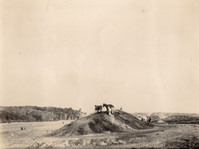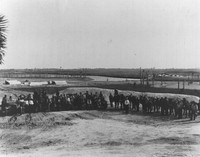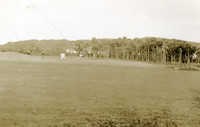



Most success stories have humble beginnings, and the Ponte Vedra Inn & Club is no exception.
The history and story of the famed, 90-year-old resort was the subject of the Beaches Museum & History Park’s Jan. 25 Boardwalk Talk, which was presented by the Inn & Club’s longtime employee and Director of Safety and Compliance Fred Cozby.
“I’ve had the honor of working at the Ponte Vedra Inn & Club for over 32 years,” said Cozby at the event held in the resort’s dining room. “It’s a very special place.”
Cozby first discussed the discovery of Ponte Vedra Beach, or Mineral City, as it was known in the early 1900s. Mining company National Lead Company, he explained, discovered a vein of minerals that stretched from the Carolinas to Melbourne, Florida, and the richest part of that vein was in Mineral City. The company purchased about 14 miles of oceanfront land in the area and ultimately mined the area for its valuable ore.
After World War I, mining operations ceased, said Cozby, and the area was struck by a land boom, as developers and visionaries like Henry Flagler began building hotels up and down the East Coast. Flagler simultaneously purchased the Florida East Coast Railway and extended it down the East Coast of Florida.
The National Lead Company and the area’s developers yearned to play a part in this land boom, said Cozby. A “highway,” which today is Ponte Vedra Boulevard, was built, as well as a nine-hole golf course known as Jacksonville Beach Golf Links that essentially served as the mining company’s playground. Built next to that course in 1928 was a 12-room log cabin that Cozby said represents the beginning of the Ponte Vedra Inn & Club.
National Lead Company, he noted, decided to bring in a British golf course architect to design an 18-hole course in Mineral City. Instead of using big earth moving equipment, they used a team of 100 mules to shape a course out of the dunes that were part of the old mining operation.
The people of National Lead Company, Cozby said, ultimately decided that if this real estate development were to be successful, they would have to change the name of the area to something catchier than Mineral City. They subsequently discovered a city in Spain that was like Jacksonville, with a river running through that ultimately connected to the Atlantic Ocean. Cozby explained that this area was originally colonized by the Romans, who built a series of bridges over the river and named the area Ponte Vedra, which translates to “Old Bridge” or “Ancient Bridge.” The mining company adopted the name, and just like that, Mineral City became Ponte Vedra Beach.
After the construction of the golf course, the next additions to the resort in the 1930s were the Racquet Club and the Bath Club (now the Surf Club), which was home to one of the first freshwater pools in Florida. In 1936, construction began on the original Inn building. Cozby noted that at the time, guests of the resort only had to pay $1.50 per day for greens fees to play golf.
"Ah, the good old days,” laughed Cozby.
In the 1940s during World War II, Cozby explained that German U-boats patrolled the shores off Ponte Vedra Beach, and one such vessel sunk the SS Gulfamerica, an American cargo ship on its maiden voyage that was transporting oil. Of its 50 crew members, Cozby said 29 survived.
The decades began to roll by, said Cozby, and the footprint of the property was in place come the 1960s. The resort added another nine holes in 1961 known as the West Nine, and then in 1977, that course was completed and became known as the Lagoon Course, bringing the resort to 36 holes.
After National Lead Company, the Ponte Vedra Inn & club was owned by Stockton, Whatley, Davin and Co. In 1983, the resort was purchased by Gate Petroleum Company. To reward its members for their loyalty over the years, Cozby noted that Gate built the Surf Club in 1985, the resort’s first fitness center in 1986 and the Spa Cottages in 1987. To round out the decade, construction of the Ponte Vedra Conference Center took place in 1989.
Moving into the 1990s, the resort constructed the Outpost in 1993 to accommodate for more functions in the area. Overlooking the Guana Lake just eight miles south of the resort, the facility can accommodate about 300 people for civic functions, cookouts, weddings and more.
In 1996, Cozby said the resort built its second-generation spa, a 10,000 square-foot facility with 100 pampering services. Then in 1997, Gate purchased the Lodge & Club, which subsequently joined forces with the Inn & Club to essentially operate as one team.
At the turn of the century, Cozby explained that Gate decided to invest between $70-100 million into the Inn & Club. The company renovated the Ocean Course and simultaneously built the resort’s parking garage, which houses the purchasing/receiving department, housekeeping and laundry services in the basement level.
Come the 2000s, Cozby noted that the resort renovated its fitness center and replaced its old Olympic pool in 2004 with what is known as the “Family Pool.” The resort constructed its third-generation spa, encompassing over 28,000 square feet and over 100 pampering services, in 2006. Renovation took place on the Lagoon Course in 2007, and the oceanfront courtyard was built in 2014. The most recently added feature, said Cozby, is the Surf Deck Grille.
“That takes us up to where we are today,” said Cozby. “We’re very privileged and honored to be a part of how all of this got to be here.”
For more information on the Ponte Vedra Inn & Club, visit https://www.pontevedra.com/inn_and_club/.